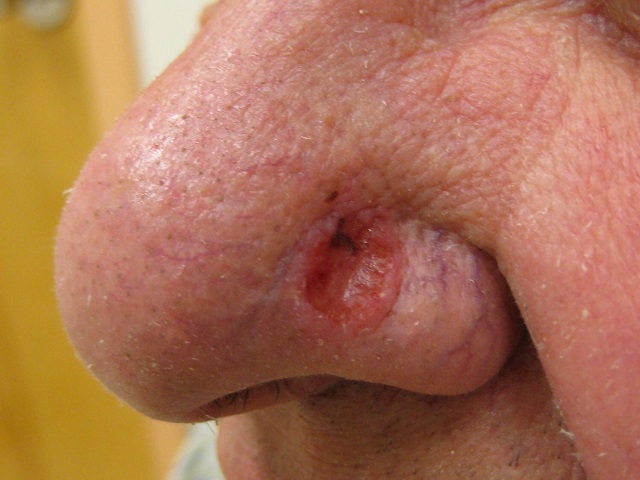5 Signs You May Have Squamous Cell Carcinoma -- Symptoms, Causes, Effects, Treatment and Prevention
Squamous cell carcinoma (SCC) is a common type of skin cancer that arises from squamous cells, which are found in the outermost layer of the skin. Squamous cell carcinoma typically develops in areas of the skin that have been exposed to the sun, such as the face, ears, lips, and hands. It can also occur on mucous membranes, such as the lining of the mouth, throat, or genitalia. SCC often appears as a thickened, scaly, or crusted lesion, which may bleed or become ulcerated. It has the potential to grow and spread to other parts of the body, although this is less common compared to melanoma. Here is an explanation of squamous cell carcinoma, along with its symptoms, diagnosis, causes, effects, treatment, and prevention:
Symptoms of Squamous Cell Carcinoma:
The signs and symptoms of squamous cell carcinoma may include:
- Thickened, scaly, or crusted area of skin
- Reddish, inflamed patch of skin
- Firm, raised bump or nodule
- Sore that does not heal or heals and then reopens
- Ulceration or bleeding of the lesion
Diagnosis of Squamous Cell Carcinoma:
Diagnosing squamous cell carcinoma usually involves a combination of clinical examination and a skin biopsy:
- Clinical examination: A healthcare professional will assess the appearance, size, and location of the suspicious skin lesion, as well as any associated symptoms.
- Skin biopsy: A sample of tissue from the lesion is taken and examined under a microscope to confirm the presence of squamous cell carcinoma cells.
Causes of Squamous Cell Carcinoma:
The primary cause of squamous cell carcinoma is long-term exposure to ultraviolet (UV) radiation from the sun or artificial sources, such as tanning beds. Other risk factors include fair skin, a history of sunburns, a weakened immune system, exposure to certain chemicals or radiation, and certain genetic disorders.
Effects of Squamous Cell Carcinoma:
If left untreated, squamous cell carcinoma can have various effects, including:
- Local tissue destruction: SCC can invade and destroy surrounding tissues, leading to functional impairment or disfigurement.
- Metastasis: Although less common than melanoma, squamous cell carcinoma has the potential to spread to nearby lymph nodes or distant organs, which can significantly impact prognosis and treatment.
Treatment of Squamous Cell Carcinoma:
The treatment of squamous cell carcinoma depends on factors such as the size, location, and stage of the tumor. Common treatment options include:
- Surgical excision: The tumor and a margin of healthy tissue are surgically removed.
- Mohs surgery: This specialized technique involves the sequential removal and examination of tissue layers to ensure complete tumor removal while preserving healthy tissue.
- Radiation therapy: High-energy beams are used to target and destroy cancer cells.
- Topical medications: Creams or gels containing medications, such as imiquimod or 5-fluorouracil, may be prescribed for superficial squamous cell carcinomas.
Prevention of Squamous Cell Carcinoma:
Preventive measures to reduce the risk of squamous cell carcinoma include:
- Limiting sun exposure: Seek shade, especially during peak sun hours, and wear protective clothing, including hats and sunglasses.
- Applying sunscreen: Use broad-spectrum sunscreen with an SPF of 30 or higher on exposed skin.
- Avoiding tanning beds: Artificial UV radiation increases the risk of skin cancer.
It is important for individuals to consult healthcare professionals for accurate diagnosis, personalized treatment plans, and prevention strategies related to squamous cell carcinoma.
References:
American Cancer Society. (2021). Skin Cancer (Non-Melanoma): Basal and Squamous Cell. Retrieved from https://www.cancer.org/cancer/basal-and-squamous-cell-skin-cancer.html
Leffell, D. J. (2019). Squamous Cell Carcinoma. In Fitzpatrick's Color Atlas and Synopsis of Clinical Dermatology (8th ed., pp. 605-608). McGraw-Hill Education.
Wong, C. S. M., Strange, R. C., & Lear, J. T. (2020). Squamous Cell Carcinoma. In Rook's Textbook of Dermatology (10th ed., pp. 49.26-49.51). Wiley.
Image Attribution:
Featured image by Dermanonymous, CC BY-SA 4.0, via Wikimedia Commons














